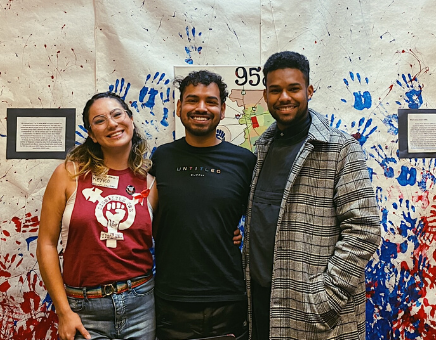Community Makes The Difference
“The Sacramento LGBT Community Center works to create a region where LGBTQ people thrive. We support the health and wellness of the most marginalized, advocate for equality and justice, and work to build a culturally rich LGBTQ community.”
Queer people, historically, with or without outside resources, have always been rooted in community. Which communities are made visible for their activism, especially in the HIV/AIDS movement, has not largely been the communities most affected – Black and Latinx people.
According to CDC data, 1 in 2 black men who have sex with men (MSM) and trans women, and 1 in 4 Latino MSM and trans women will be diagnosed with HIV during their lifetime. Sacramento County is currently home to 4,323 people living with HIV. Of those, 25.1% are Black, and 19.9% are Latinx. While neither of these are a majority, only, 10.9% of people living in Sacramento are Black, meaning Black folks are affected by HIV at a rate of over 200% higher than their portion of the population.
World AIDS Day is meant to demonstrate our unity in the fight against HIV, helps us to commemorate those we have lost to an AIDS-related illness, and also to show support for those who are living with HIV. This year’s theme was “Community Makes the Difference,” and community has showed up in many ways that have been memorialized; However, communities, often communities living on the margins, have also showed up in countless other ways that aren’t as recognized, or even worse, forgotten. Our intention with this year was to commemorate the work that ALL communities have done in the HIV movement, and in particular, to highlight the Queer & Trans People of Color (QTPOC) and their contributions to community – For Us, By Us.
This Year’s World AIDS Day
In collaboration with community members across Sacramento such as the Gender Health Center, this year we held an interactive experience with 4 exhibits:
Our first exhibit was a timeline that revealed that HIV/AIDS existed prior to the United States, largely affecting Black folks across the world. Our intention was to, as best as possible, commemorate ALL of those we have lost. Narratives often are focused on the West, and it was important for us to recognize those who have been erased and forgotten from the HIV/AIDS timeline – HIV has been traced to 1920 in Kinshasa in the Democratic Republic of Congo, not the popular belief it emerged in the 80s.
The next piece of the exhibit was the 95823 room – this room served the purpose of understanding how HIV affects our local community, and in particular, the Sacramento Black and Latinx communities. We see that the concentration of people living with HIV is in South Sacramento, where largely Black and Brown communities live AND thrive. We displayed art from local queer Black artists to auction off in an effort to convey that supporting local Black and Latinx folks and business is a tangible way of HIV prevention for our communities.
Our next two exhibits honored the activism in the world of queer nightlife and POC warriors in the AIDS movement.The Latex Ball and Proyecto Contra Sida Por Vida (Proyecto) were two organizations that we chose to highlight because they have shaped the lives of our Queer and Trans Black and Latinx Communities. The Latex Ball was founded in 1990 by the House and Ballroom community in collaboration with The GMHC (formerly Gay Men’s Health Crisis) to raise awareness about prevention and to provide support for those who are living with HIV/AIDS. Proyecto was founded in 1993 in San Francisco for all the same reasons, but specifically focused on the Latinx community. Proyecto worked in queer Latinx clubs to promote sexual health education, and also produced bilingual commercials to best serve the Latinx community in San Francisco. The Latex Ball and Proyecto were born out of necessity due to community needs not being met, and to this day are still not being met as statistics tell us.
Moving Forward
While donating to organizations like The Sacramento LGBT Community Center is an important way to help marginalized communities, one of the most effective ways to help is to donate directly and use the services of local Black folks, Indigenous people, and people of color (BIPOC). Sacramento is home to many Black and Latinx artists, chefs, musicians, and other kinds of business owners. Support your local BIPOC community members, offer rides when possible, donate money directly to them, and support them however you can. We cannot do this alone – community makes the difference.

